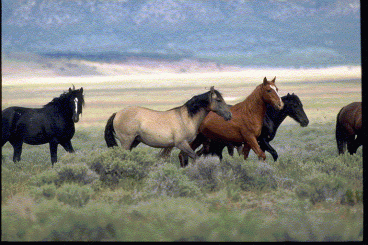 An open letter to legislators and elected state and county officials
An open letter to legislators and elected state and county officialsBy William E. Simpson II, Executive Director Wild Horse Fire Brigade
Photo: Wild mustangs, courtesy U.S. Bureau of Land Management
April 9, 2023 (San Diego) -- A New Study conducted by 84-researchers and published in Science magazine (March 2023) dispels the myth that horses didn't exist in America until the Spanish arrived, and proves that horses were already living in North America at the time of the Spanish arrival. And we know that wild horses were documented by Sir Francis Drake in 1580 as living among the local indigenous peoples in the area along what is today the Oregon-California border.
This revelation means that Oregon and California (and other states) land and wildlife managers must change the current paradigm of mismanaging wild horses as a non-native species.
As a true native species in North America, they rightfully belong in our wilderness ecosystems, where they provide an extremely valuable service to taxpayers by mitigating wildfire fuels year-round in areas not suited to other methods.
Leading analysts in the insurance industry are already endorsing the use of wild horses for wildfire fuels reduction, as we see in this AM BEST TV program. See also:
It’s time for everyone to move forward and drop the nonsense that wild horses are not native to North America, so we can begin managing them appropriately.
Wild Horses offer a huge value proposition to taxpayers and our ecosystems. They are understudied due to scant government and industry funding. Our Org. Wild Horse Fire Brigade has made and published numerous discoveries about the benefits of managing wild horses in wilderness areas that are appropriate. This press release discusses that topic.
Following is a quote from the study as published in Science:
"Making a horse culture
Horses evolved in North America and dispersed to Eurasia across the Bering Land Bridge. They continued to evolve and were domesticated in Eurasia, but, as far as we know, they became extinct in North America by the late Pleistocene and were then reintroduced by European colonizers. Taylor et al. looked at the genetics of horses across the Old and New Worlds and studied archaeological samples. They found no evidence for direct Pleistocene ancestry of North American horses, but they did find that horses of European descent had been integrated into indigenous cultures across western North America long before the arrival of Europeans in that region. —SNV
Abstract
The horse is central to many Indigenous cultures across the American Southwest and the Great Plains. However, when and how horses were first integrated into Indigenous lifeways remain contentious, with extant models derived largely from colonial records. We conducted an interdisciplinary study of an assemblage of historic archaeological horse remains, integrating genomic, isotopic, radiocarbon, and paleopathological evidence. Archaeological and modern North American horses show strong Iberian genetic affinities, with later influx from British sources, but no Viking proximity. Horses rapidly spread from the south into the northern Rockies and central plains by the first half of the 17th century CE, likely through Indigenous exchange networks. They were deeply integrated into Indigenous societies before the arrival of 18th-century European observers, as reflected in herd management, ceremonial practices, and culture."
-----------
Conclusion
American wild horses are a national treasure and a heritage species. As such, and in light of new scientific revelations, wild horses must be managed by all government agencies in a manner consistent with 'native species' status and in consideration that America only has a total population (free and not genetically molested) of under 100,000 animals.
Of great genetic concern is that the Bureau of Land Management ('BLM') and United States Forest Service ('USFS'), are in many areas called Herd Management Areas ('HMA'), managing wild horse herd sizes using arbitrary population limitation assignments called Appropriate Management Levels ('AMLs') that guarantee a loss of heterozygosity and inbreeding (loss of genetic vigor).
Many Herd Management Areas (HMAs) have less than 150-200 horses, which according to science and the BLM's own Management Handbook, is the minimum population in order to maintain heterozygosity and genetic vigor.
Quote from page 22 of the BLM's 'Wild Horses and Burro Management Handbook':
4.4.6.3 Herd Size
A minimum population size of 50 effective breeding animals (i.e., a total population size of about 150-200 animals) is currently recommended to maintain an acceptable level of genetic diversity within reproducing WH&B populations (Cothran, 2009)
One of many examples of current mismanagement that can be made is the AML for the BLM's Pokegama wild horse HMA, which is managed with an AML of "30-50" wild horses.
America was build off the backs of its wild horses and they deserve our respect and proper genetically sustainable management. Please contact all of your elected officials and offer this article as irrefutable evidence of the current mismanagement.
The opinions in this reader’s editorial reflect the views of the author and do not necessarily reflect the views of East County Magazine. To submit an editorial for consideration, contact editor@eastcountymagazine.org











Comments
LOL
Did you miss the evidence cited?
Even Sir Francis Drake, the early explorer, wrote of seeing wild horses already here.
Also I've seen in other sources that there's now DNA evidence showing horses in San Diego County before the Spaniards arrived.